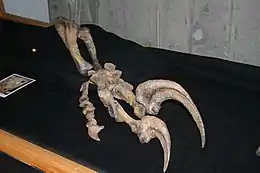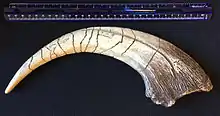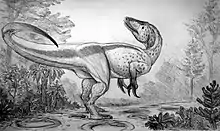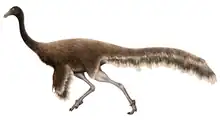Megaraptor
Megaraptor (lit. 'large thief') is a genus of large theropod dinosaur that lived in the ages of the Late Cretaceous.[2][3] Its fossils have been discovered in the Patagonian Portezuelo Formation of Argentina, South America. Initially thought to have been a giant dromaeosaur-like coelurosaur, it was classified as a neovenatorid allosauroid in previous phylogenies, but more recent phylogeny and discoveries of related megaraptoran genera has placed it as either a basal tyrannosauroid or a basal coelurosaur with some studies still considering it a neovenatorid.[4][5]
| Megaraptor Temporal range: Late Cretaceous, [1] | |
|---|---|
 | |
| Reconstructed hand | |
| Scientific classification | |
| Domain: | Eukaryota |
| Kingdom: | Animalia |
| Phylum: | Chordata |
| Clade: | Dinosauria |
| Clade: | Saurischia |
| Clade: | Theropoda |
| Clade: | †Megaraptora |
| Family: | †Megaraptoridae |
| Genus: | †Megaraptor Novas 1998 |
| Species: | †M. namunhuaiquii |
| Binomial name | |
| †Megaraptor namunhuaiquii Novas 1998 | |
Description



Megaraptor was initially described as a giant dromaeosaur, known primarily from a single claw (about 30 cm long) that resembled the sickle-shaped foot claw of dromaeosaurids.[2] The discovery of a complete front limb, however, showed that this giant claw actually came from the first finger of the hand. In 2010, Gregory S. Paul estimated its length at 8 metres (26 ft), its weight at 1 tonne (2,200 lb).[6] The hands were unusually elongated, bearing sickle-shaped claws even more recurved than those of spinosaurids.[7]
Classification
The hand is quite distinct from other basal tetanurans, so it was not initially clear whether Megaraptor was an allosaurid, a carcharodontosaurid, a spinosauroid, or something else entirely.[3] Subsequent studies, as well as the identification of close relatives with similar large claws on the forelimbs (see below), helped identify Megaraptor as a highly advanced and lightly built allosauroid, and a member of the family Neovenatoridae.[8] More recent studies have proposed that Megaraptor and its kin are actually tyrannosauroids[9] or spinosauroids[10] as opposed to allosauroids.[9] A juvenile specimen described in 2014 has provided more evidence towards Megaraptor being a primitive tyrannosauroid.[11] The discovery of Gualicho indicates that Megaraptor may not be a tyrannosauroid, but either an allosauroid or basal coelurosaur.[12]
When first discovered and prior to publication, the spinosaurid Baryonyx was also reported to be a dromaeosaurid, and the allosauroid Chilantaisaurus was reported to be a possible spinosaurid, both based on the large hand claws.
The cladogram shown below follows an analysis by Porfiri et al., 2014.[1]
| Megaraptora |
| |||||||||||||||||||||
In the 2022 description of Maip, Rolando et al. noted the presence of two distinct megaraptoran clades: a more inclusive clade, comprising all megaraptorids except Fukuiraptor and Australovenator, (shown below as "Clade A"), and a more exclusive clade of larger, entirely South American megaraptorids (shown below as "Clade B"). Like some previous analyses by other authors, Megaraptora is nested within Coelurosauria, as the sister taxon to Tyrannosauroidea. The cladogram below displays the megaraptoran results of the phylogenetic analyses by Rolando et al (2022).[13]
| Megaraptora |
| |||||||||||||||||||||||||||||||||||||||||||||||||||||||||||||||
Paleoecology

Megaraptor is known from the Late Turonian to Early Coniacian-dated Portezuelo Formation of Argentina. Other named dinosaurs known from the formation include the titanosaurian sauropods Futalognkosaurus, Baalsaurus, and Malarguesaurus, and several other theropod taxa including the dromaeosaurids Neuquenraptor, Unenlagia, and Pamparaptor, the alvarezsaurid Patagonykus, and the abelisaurid Elemgasem.[14] Indeterminate remains belonging to an unnamed megaraptorid, a possible noasaurid, and ornithopods have also been recovered from the formation. Fossils of teleost fish (Leufuichthys), turtles (Portezueloemys and a species of Prochelidella), birds, and pterosaurs (Argentinadraco) are also known.
References
- Juan D. Porfiri; Fernando E. Novas; Jorge O. Calvo; Federico L. Agnolín; Martín D. Ezcurra; Ignacio A. Cerda (2014). "Juvenile specimen of Megaraptor (Dinosauria, Theropoda) sheds light about tyrannosauroid radiation". Cretaceous Research. 51: 35–55. doi:10.1016/j.cretres.2014.04.007. hdl:11336/12129.
- Novas, F.E. (1998). "Megaraptor namunhuaiquii, gen. et sp. nov., a large-clawed, Late Cretaceous theropod from Patagonia". Journal of Vertebrate Paleontology. 18: 4–9. doi:10.1080/02724634.1998.10011030.
- Calvo, J. O.; Porfiri, J.D.; Veralli, C.; Novas, F.E.; Poblete, F. (2004). "Phylogenetic status of Megaraptor namunhuaiquii Novas based on a new specimen from Neuquén, Patagonia, Argentina". Ameghiniana. 41: 565–575.
- Rauhut, Oliver (2019). "Probable basal allosauroid from the early Middle Jurassic Cañadón Asfalto Formation of Argentina highlights phylogenetic uncertainty in tetanuran theropod dinosaurs". Sci Rep. 9 (1): 18826. Bibcode:2019NatSR...918826R. doi:10.1038/s41598-019-53672-7. PMC 6906444. PMID 31827108.
- "Just out | A new megaraptoran theropod dinosaur from the Upper Cretaceous Bajo de la Carpa Formation of northwestern Patagonia @ Cretaceous Research".
- Paul, G.S., 2010, The Princeton Field Guide to Dinosaurs, Princeton University Press p. 99
- Calvo, J.O., Porfiri, J.D., González-Riga, B.J., and Kellner, A.W. (2007) "A new Cretaceous terrestrial ecosystem from Gondwana with the description of a new sauropod dinosaur". Anais da Academia Brasileira de Ciências, 79(3): 529–41.
- Benson, R.B.J.; Carrano, M.T; Brusatte, S.L. (2010). "A new clade of archaic large-bodied predatory dinosaurs (Theropoda: Allosauroidea) that survived to the latest Mesozoic". Naturwissenschaften. 97 (1): 71–78. Bibcode:2010NW.....97...71B. doi:10.1007/s00114-009-0614-x. PMID 19826771. S2CID 22646156.
- F. E. Novas; F. L. Agnolín; M. D. Ezcurra; J. I. Canale; J. D. Porfiri (2012). "Megaraptorans as members of an unexpected evolutionary radiation of tyrant-reptiles in Gondwana". Ameghiniana. 49 (Suppl): R33.
- Holtz, T.R. Jr. (2012). Dinosaurs: The Most Complete, Up-to-date Encyclopedia for Dinosaur Lovers of All Ages. Random House Books for Young Readers. pp. 95–96. ISBN 978-0-375-82419-7.
- Porfiri, J. D., Novas, F. E., Calvo, J. O., Agnolín, F. L., Ezcurra, M. D. & Cerda, I. A.; Novas; Calvo; Agnolín; Ezcurra; Cerda (2014). "Juvenile specimen of Megaraptor (Dinosauria, Theropoda) sheds light about tyrannosauroid radiation". Cretaceous Research. 51: 35–55. doi:10.1016/j.cretres.2014.04.007. hdl:11336/12129.
{{cite journal}}: CS1 maint: multiple names: authors list (link) - Apesteguía, Sebastián; Smith, Nathan D.; Juárez Valieri, Rubén; Makovicky, Peter J. (2016). "An Unusual New Theropod with a Didactyl Manus from the Upper Cretaceous of Patagonia, Argentina". PLOS ONE. 11 (7): e0157793. Bibcode:2016PLoSO..1157793A. doi:10.1371/journal.pone.0157793. PMC 4943716. PMID 27410683.
- Rolando, Alexis M. A.; Motta, Matias J.; Agnolín, Federico L.; Manabe, Makoto; Tsuihiji, Takanobu; Novas, Fernando E. (2022-04-26). "A large Megaraptoridae (Theropoda: Coelurosauria) from Upper Cretaceous (Maastrichtian) of Patagonia, Argentina". Scientific Reports. 12 (1): Article number 6318. Bibcode:2022NatSR..12.6318A. doi:10.1038/s41598-022-09272-z. PMC 9042913. PMID 35474310.
- Baiano, Mattia A.; Pol, Diego; Bellardini, Flavio; Windholz, Guillermo J.; Cerda, Ignacio A.; Garrido, Alberto C.; Coria, Rodolfo A (2022-09-05). "Elemgasem nubilus: a new brachyrostran abelisaurid (Theropoda, Ceratosauria) from the Portezuelo Formation (Upper Cretaceous) of Patagonia, Argentina". Papers in Palaeontology. 8 (5): e1462. doi:10.1002/spp2.1462. S2CID 252097368.

.jpg.webp)












